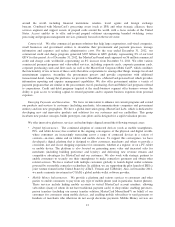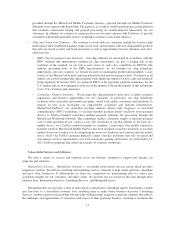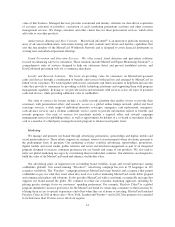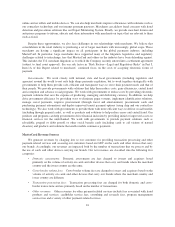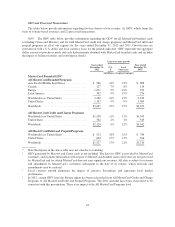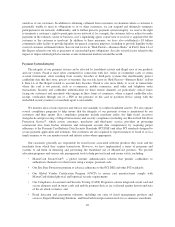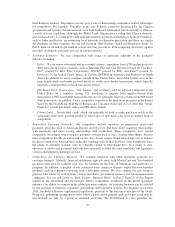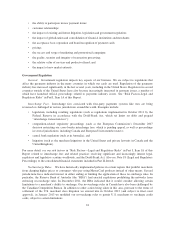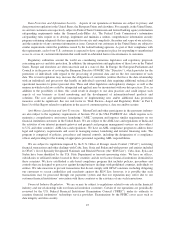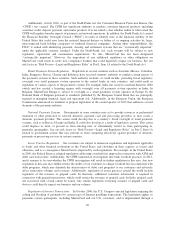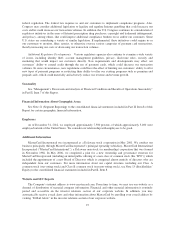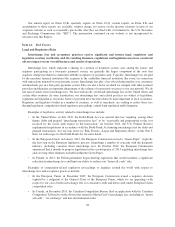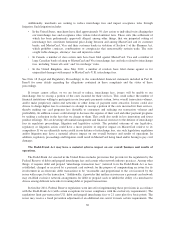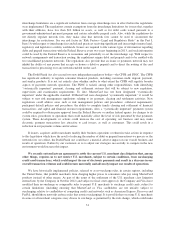MasterCard 2012 Annual Report Download - page 25
Download and view the complete annual report
Please find page 25 of the 2012 MasterCard annual report below. You can navigate through the pages in the report by either clicking on the pages listed below, or by using the keyword search tool below to find specific information within the annual report.Enterprise Risk Management
We face a number of risks in operating our business (for a description of material risks, see “Risk Factors”
in Part I, Item 1A of this Report). Managing risk is an integral component of our business activities and the
degree to which we manage risk is vital to our financial condition and profitability. We have an Enterprise Risk
Management (“ERM”) program which is integrated with the business and designed to ensure appropriate and
comprehensive oversight and management of end-to-end risk. The ERM program leverages our business
processes to, among other things, ensure: allocation of resources to appropriately address risk; establishment of
clear accountability for risk management; and provision of transparency of risks to senior management (including
our Risk Management Committee), the Board of Directors and appropriate Board committees. Our ERM
program seeks to accomplish these goals by: identifying, prioritizing and monitoring key risks; providing an
independent view of our risks; and strengthening business operations by integrating ERM principles and
continuing to create a risk aware culture within MasterCard. Our integrated risk management structure balances
risk and return by having business units and central functions (such as finance and law) identify, own and
manage risks, our executive officers set policy and accountability and our Board of Directors and its committees
provide oversight of the process.
Intellectual Property
We own a number of valuable trademarks that are essential to our business, including MasterCard®,
Maestro®and Cirrus®, through one or more affiliates. We also own numerous other trademarks covering various
brands, programs and services offered by MasterCard to support our payment programs. Trademark and service
mark registrations are generally valid indefinitely as long as they are used and/or properly maintained. Through
license agreements with our customers, we authorize the use of our trademarks in connection with our customers’
card issuing and merchant acquiring businesses. In addition, we own a number of patents and patent applications
relating to payments solutions, transaction processing, smart cards, contactless, mobile, electronic commerce,
security systems and other matters, some of which may be important to our business operations. Patents are of
varying duration depending on the jurisdiction and filing date, and will typically expire at the end of their natural
term.
Competition
General. Our programs compete against all forms of payment, including paper-based transactions
(principally cash and checks); card-based and other electronic payments systems and solutions, including credit,
charge, debit, prepaid, private-label and other types of general purpose and limited use programs; contactless,
mobile and web-based payment platforms; and other electronic transactions such as wire transfers and
Automated Clearing House payments. As a result of a global trend, electronic forms of payment such as payment
cards are increasingly displacing paper forms of payment, and card brands such as MasterCard, Visa, American
Express and Discover are benefiting from this displacement. However, cash and checks still capture the largest
overall percentage of worldwide payment volume.
Cash and Check.
• Cash and check continue to represent the most widely used forms of payment. Approximately 85% of
all payment transactions are represented by paper-based transactions with cash or check.
Payment Card, Processing and Alternative Competitors.
•General Purpose Payment Card Industry. Within the general purpose payment card industry, we face
substantial and increasingly intense competition worldwide from systems such as Visa (including Plus®,
Electron®and Interlink®), American Express and Discover, among others. Within the global general
purpose payment card industry, Visa has significantly greater volume than we do. Outside of the United
States, some of our competitors such as JCB in Japan and UnionPay in China have leading positions in
21



